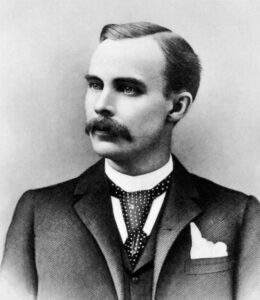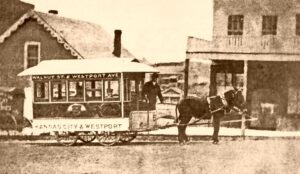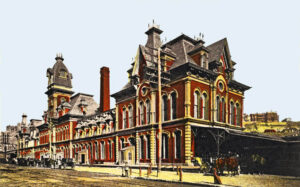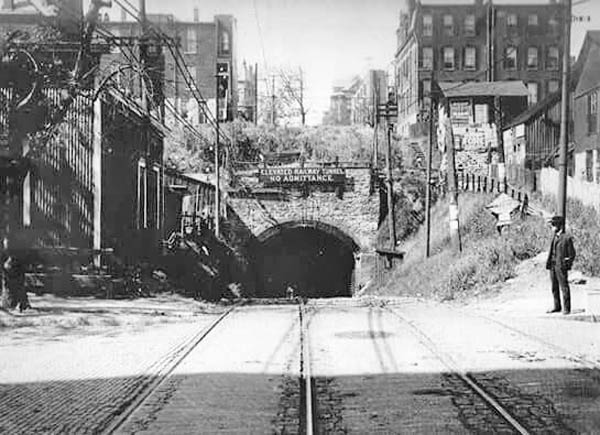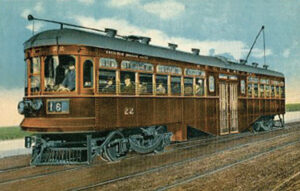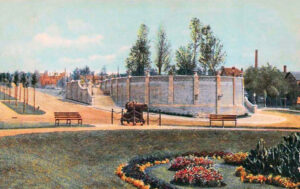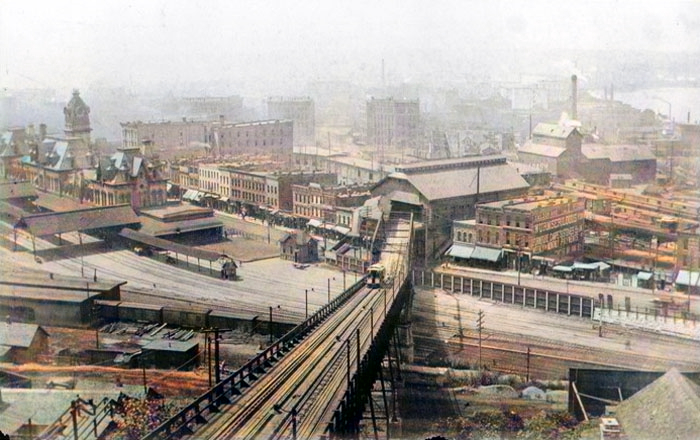Robert Gillham founded Kansas City, Missouri’s Cable Railway System. He was one of the pioneers in cable railway construction, and when he entered this field, there were only three cable railways in the country, all in San Francisco, California.
Robert Gillham was born in New York City, New York, on September 25, 1854, to John and Clarissa Carson Gillham. One of four sons, Robert’s education was obtained at a private school in Lodi, New Jersey. At the age of 16, he became a student at the Classical and Mathematical Institute in Hackensack, New Jersey. Later, he entered the office of Professor William Williams, principal of the institute, and under his private tutelage, continued the study of engineering until 1874, when, at the age of 20, he established an office in Hackensack as an engineer. Working diligently, numerous important engineering enterprises were entrusted to him, embracing the construction of bridges and special sewerage, sanitary engineering, and reports of different kinds. These jobs rapidly extended his reputation as an engineer and brought him much more work in and about New York City.
Early in October 1878, Gillham visited the great West and arrived in Kansas City in the latter part of the same month. A little investigation was sufficient to impress him with the idea that Kansas City would become one of the most important points in the rapidly developing West. He soon settled in the city, where he remained for the rest of his life.
At that time, the small town was almost inaccessible. What struck him as one of the most conspicuous drawbacks to Kansas City’s advancement was its crude and, in every sense, inadequate street railway system. At that time, the public was compelled to reach the city proper on the hill by a tedious ride up Bluff Street to Fifth Street on slow mule cars, then the only ones in operation. He then studied some quick and modern means of transit between Main Street and the Union Depot.
After much consideration and setting aside other important projects, he determined the construction of the Eighth and Ninth Street Cable Road with the viaduct at the Union Depot. Through the influence of the horse railway company and others opposed to the enterprise, the granting of the franchise was initially refused. Finally, the city council promised that the concession would be granted if Ninth Street, between Delaware Street and Broadway, was widened. Through Gillham’s influence, this measure was finally accomplished, and from a narrow side street inadequate to the city’s business, Ninth Street was widened. However, the granting of the franchise was postponed.
Gillham married Amanda Marty in 1881, and the couple would have three children.
Undaunted, Gillham again bent his energies to securing the right to build the road, destined, as he believed, to do more for the city than any other enterprise within its borders. At length, the franchise was granted to him and his associates, including W. J. Smith, the company’s president, and George J. Keating, who withdrew from the enterprise soon after the passage of the franchise. The construction of the line was a significant engineering undertaking. Not only did Gillham design and build the road, but every dollar used in its construction was secured through his efforts.
Before the completion of the Ninth Street Line, Gillham conceived the idea of an elevated railway across the bottoms of West Kansas to Wyandotte (Kansas City, Kansas) and began the circulation of a petition to secure the right to build such a road. Shortly afterward, without knowledge of Gillham’s plans, D.M. Edgerton of St. Louis proposed to do the same thing. They soon met upon common ground and united their efforts for their common cause. With the assistance of friends, they fought hard and long against injunctions and other litigations and slowly but surely modified the prejudices of property owners along the line of the proposed road. The franchise was defeated twice in the council but was finally granted. Then, through their efforts, Gillham and Edgerton secured the money necessary to construct the road, which was a marked success. It opened in 1888. From an engineering point of view, the elevated structure was superior to all others in the country for its beauty of design, strength, durability, and lightness.
After operating the road to St. Louis Avenue and connecting with the Ninth Street Cable Line for more than a year, it was necessary to accommodate its patrons and increase its business, to extend it by some means to Delaware Street in the heart of the city. However, a towering bluff intervened, and it was not feasible to reach the top of this by an inclined viaduct. The difficulty could be surmounted only by a most skillful and ingenious engineer, and by unanimous consent of all concerned, the task was entrusted to Gillham, who designed a cable railway elevated from St. Louis Avenue to the bluff at the foot of Eighth Street, piercing the bluff utilizing a double track cable railway tunnel, intersecting Washington Street on the surface and extending along the surface of Eighth Street to Delaware Street. This was a bold undertaking, which, by some engineers, was considered impracticable. Work began in the spring of 1887, and in less than eleven months from the day that ground was broken, trains were running through the tunnel to Delaware Street and returning.
Gillham was also one of the principal organizers of the Grand Avenue Cable Railway Company, which opened in 1887 and was called to be its first chief engineer. However, with numerous other duties, he declined the appointment. Associated with W. J. Smith, he purchased a half interest in the old Grand Avenue Horse Railway Company and the Kansas City and Westport Railway Company by contract. He associated with them some of the original owners and many of the present stockholders in the Grand Avenue Cable Railway Company, who organized the corporation. Gillham resigned from the directory when he sold his cable stock in this company.
He was also president and chief engineer of the People’s Cable Railway Company, which he assisted in organizing. He was a director and one of the largest stockholders of the Inter-State Consolidated Rapid Transit Railway Company (the Elevated Railway Company). He also constructed the Riverview Cable Railway and was primarily interested in the Omaha Cable Traction Company of Omaha, Nebraska, whose roads he constructed as chief engineer. He also consulted on the application of cable railways in St. Joseph, Missouri; Nashville, Tennessee; Cleveland, Ohio; Fort Worth, Texas; Providence, Rhode Island; Brooklyn, New York; Scranton, Pennsylvania; and many other cities. He also consulted on the matter of elevated railways in Chicago, Illinois.
When he went to work for the Kansas City Cable Railway Company, he made $5,000 a year. Soon he was given $10,000 a year, and in a few months, Denver and Omaha had employed him to engineer their street railway systems. He received $10,000 a year from each of these and was soon making $40,000 to $50,000 a year in salaries — the highest salaried man that Kansas City ever had up until that time.
He was at the same time identified with other enterprises of particular importance to Kansas City. He was the president of the Armourdale Foundry Company, a company organized originally by Mr. C. E. Moss. When Moss retired, Gillham owned the controlling interest in the extensive manufacturing concern.
Gillham also helped plan and promote the city’s Parks and Boulevard system and began serving on the Board of Park Commissioners in 1895.
In 1895, Kansas City had the third largest cable car system in the United States, behind San Francisco and Chicago.
Gillham capped his engineering career by constructing the Kansas City, Pittsburg, and Gulf Railroad and its terminus at Port Arthur, Texas. He then became general manager of the railroad. In May 1899, the railroad was already in receivership when he made a laborious trip of ten days over the road with the receivers. The trip had taxed his strength, and he had caught a cold and returned home. After being ill for only six days, he died at his residence from complications of pneumonia and appendicitis on May 19, 1899, at the age of 44. He was buried in Forest Hill Cemetery in Kansas City. It was thought by those who knew him that he had exhausted himself and pushed himself too much.
The Park Board named a developing major roadway for him, Robert Gillham Road.
Ending thirty years of cable car dominance, the last operating cable car in Kansas City completed its final trip along 12th Street on October 13, 1913. By then, electric streetcars proved more energy efficient, required less maintenance and were easier to construct than cable cars.
©Kathy Alexander/Legends of America, updated January 2024.
Also See:
Historic People of Kansas City
Sources:
Case, Theodore S.; History of Kansas City Missouri, D. Mason & Co.; Syracuse, New York, 1888
The Craig (Colorado) Courier, May 27, 1899
Facebook – Kansas City Parks
KC History
Missouri State Historical Society
Scripps Local Media

